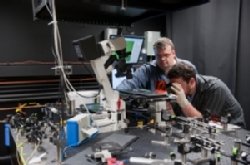Biology from a physics perspectitve
Martin Forstner's work spans four research laboratories

On any given day, Martin B. Forstner can be found working in one or all of four laboratories—some appear similar to those of his physicist colleagues and others look as if they belong in Syracuse University’s Life Sciences Complex.
Forstner, assistant professor in SU’s College of Arts and Sciences, is a biophysicist who investigates how the laws of physics influence the organization, structure, and function of cell membranes in living organisms. He seeks to apply the principles of soft condensed matter physics to biological systems. Soft matter includes liquids, gels, and foams as well as biological materials, and is found in everything from packaging materials and adhesives to detergents, lubricants, cosmetics, and food and fuel additives.
“We can construct hard materials, such as semiconductors, that are based on fixed crystal structures, which are not fluid,” Forstner says. “Imagine if we could exploit the physics of soft, biological systems to build new technologies and drugs that could adapt and respond to the surrounding environment.”
Last year, Forstner received a prestigious, five-year, $795,000 National Science Foundation (NSF) Early Career Development (CAREER) Award to further his research and develop high-school teaching materials on biophysics and soft condensed matter physics.
To do his work, Forstner needs biology, molecular chemistry, and advanced optics laboratories. The diverse array of equipment enables his research team to investigate how lipids (fatty molecules) reassemble, move, and reorganize on the surface of living cells as well as develop new optical tools to extend the reach of biophysical research.
Lipids form an essential barrier (the cell membrane) to control the movement of materials in and out of cells. Lipids can also move within membranes. This property enables cells, and structures within cells (called organelles), to have a fluid surface, change shape, and move. Lipids are also thought to contribute to the dynamic restructuring and reorganization of other molecules found in cell membranes, but little is known about how this process works. A growing body of evidence suggests that malfunctions in cell membrane organization contribute to a number of diseases, including Alzheimer’s, cancers, and autoimmune diseases.
“Much of our understanding of cell membranes is derived from looking at the biochemical pathways, proteins, and enzymes that control the movement of materials within and across the membrane,” Forstner says. “What has not been strongly considered are the dynamic processes that occur because of the physics of the system. There is much to be learned by looking at biology from a physics perspective.”
Forstner, assistant professor in SU’s College of Arts and Sciences, is a biophysicist who investigates how the laws of physics influence the organization, structure, and function of cell membranes in living organisms. He seeks to apply the principles of soft condensed matter physics to biological systems. Soft matter includes liquids, gels, and foams as well as biological materials, and is found in everything from packaging materials and adhesives to detergents, lubricants, cosmetics, and food and fuel additives.
“We can construct hard materials, such as semiconductors, that are based on fixed crystal structures, which are not fluid,” Forstner says. “Imagine if we could exploit the physics of soft, biological systems to build new technologies and drugs that could adapt and respond to the surrounding environment.”
Last year, Forstner received a prestigious, five-year, $795,000 National Science Foundation (NSF) Early Career Development (CAREER) Award to further his research and develop high-school teaching materials on biophysics and soft condensed matter physics.
To do his work, Forstner needs biology, molecular chemistry, and advanced optics laboratories. The diverse array of equipment enables his research team to investigate how lipids (fatty molecules) reassemble, move, and reorganize on the surface of living cells as well as develop new optical tools to extend the reach of biophysical research.
Lipids form an essential barrier (the cell membrane) to control the movement of materials in and out of cells. Lipids can also move within membranes. This property enables cells, and structures within cells (called organelles), to have a fluid surface, change shape, and move. Lipids are also thought to contribute to the dynamic restructuring and reorganization of other molecules found in cell membranes, but little is known about how this process works. A growing body of evidence suggests that malfunctions in cell membrane organization contribute to a number of diseases, including Alzheimer’s, cancers, and autoimmune diseases.
“Much of our understanding of cell membranes is derived from looking at the biochemical pathways, proteins, and enzymes that control the movement of materials within and across the membrane,” Forstner says. “What has not been strongly considered are the dynamic processes that occur because of the physics of the system. There is much to be learned by looking at biology from a physics perspective.”
Media Contact
Judy Holmes
